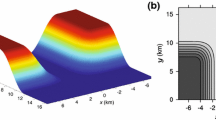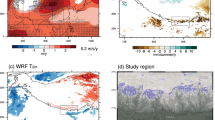Summary
A daily mountain-valley circulation in the Puebla-Tlaxcala valley (Mexico) as a part of a meso-scale mountain wind system on the eastern slope of the Sierra Madre Oriental is discussed based on observations. A special feature of this circulation is the existence of a valley wind until midnight during the rainy season months. In the course of the year the mountain-valley circulation at Puebla-Tlaxcala undergoes sharp modifications: incursions of cold air masses during the winter periods and interactions with the northward moving ITC and high pressure cells which encroach into the Central Meseta in summer-time. The convergent wind fields which develope in the middle of this elevated basin are generally aress of highest rainfall generation. The three-dimensional structure of the mountain-valley circulation appears to only partially satisfy known meteorological models since these low-level surface wind currents are periodically superimposed upon by larger scale synoptic features from the north; these larger synoptic features, thus, distort the simplified picture of an elevated return flow or “anti-wind”.
Zusammenfassung
Eine tageszeitlich wechselnde Berg-/Talwindzirkulation als Teil eines großräumigen tagesperiodischen Gebirgswindsystems am Ostabfall der Sierra madre Oriental wird für das Hochtal von Puebla-Tlaxcala nachgewiesen. Dabei ist ein Fortbestehen der Talwindzirkulation bis Mitternacht in den Monaten der Regenzeit eine Besonderheit dieser Zirkulation. Im Laufe des Jahres wird die Berg-/Talwindzirkulation im Hochtal von Puebla-Tlaxcala während der Wintermonate durch einbrechende Kaltluftmassen, während der Sommermonate durch Nordwanderungen der ITC und Höhenantizyklonen, die sich über der Mesa Central von Mexiko ausbilden, stark modifiziert. Es entstehen Windrichtungskonvergenzen im Zentrum des Hochbeckens, die niederschlagsgenetisch höchst aktiv sind. Die dreidimensionale Struktur der Berg-/Talwindzirkulation entspricht nur teilweise den bekannten Modellen, da die bodennahe Grundströmung regelmäßig durch eine synoptische Nordströmung überlagert wird, durch welche eine starke Verfälschung des “Antiwindes” entsteht.
Similar content being viewed by others
References
Buettner, J. K., and N. Thyer: Valley Winds in the Mount Rainier Area. Arch. Met. Geoph. Biokl., Ser. B,14, 125–147 (1966).
Crutcher, H. R.: Upper Wind Statistics Charts of the Northern Hemisphere. NAVAER 50-JC-531, Vol.I andII (1959).
Defant, F.: Local Winds. Comp. of Meteorol., 655–672 (1951).
Flohn, H.: Beiträge zur Meteorologie des Himalaya. Khumbu Himal.7/2, 25–47 (1970).
Flohn, H.: Beiträge zur vergleichenden Meteorologie der Hochgebirge. Annal. Meteorol., Neue Folge5, 9–15 (1971).
Fujita, T. T., K. Watanabe, and T. Izawa: Formation and Structure of Equatorial Anticyclones caused by Large-Scale Cross Equatorial Flows Determined by ATS-I Photographs. SMRP-Research Paper No.78 (1969).
Jáuregui, E.: Mesoclima de la Región Puebla-Tlaxcala. UNAM, Instituto de Geografía, México (1968).
Jáuregui, E.: The Urban Climate of Mexico-City. ErdkundeXXVII/4, 298–307 (1973).
Klaus, D.: La irradiación solar máxima posible en pendientes inclinades en la zone de Puebla y Tlaxcala. Comunicaciones del Proyeco Puebla-Tlaxcala1, Puebla, México, 39–49 (1970).
Klaus, D.: Zusammenhänge zwischen Wetterlagenhäufigkeit und Niederschlagsverteilung im Zentralmexikanischen Hochland. ErdkundeXXV/2, 81–90 (1971).
Klaus, D.: Niederschlagsgenese und Niederschlagsverteilung im Hochtal von Puebla-Tlaxcala. Bonner Geogr. Abh., 1975 (in print).
Klaus, D.: Las invasions de aire frío en los trópicos en la región de sotavento de las montañas Rocallosas. Geofísica Internacional, México, Vol. 13 (2), 99–143 (1973).
Lauer, W.: Naturwissenschaftliche Arbeiten im Rahmen des Mexiko-Projektes der Deutschen Forschungsgemeinschaft. Deutsche Geograph. Forschung in der Welt von heute, 29–38 (1970).
Lauer, W.: Zusammenhänge zwischen Klima und Vegetation am Ostafall der mexikanischen Meseta. ErdkundeXXVII/3, 192–213 (1973).
Mosiño, P.: Una clasificación de las configuraciones de flujo aéreo sobre la República Mexicana. Revista de Ingeniería Hidráulica, S. R. H.XII/2, México (1958).
Mosiño, P., y E. García: Evaluación de la sequía intreestival en la República Mexicana. Colegio de Postgraduados, Escuela Nacional de Agricultura6, Chapingo, México, 35–59 (1968).
Reiter, R.: Luttverunreinigung und Klenionendichte in Abhängigkeit von Windströmung und Austausch. Arch. Met. Geoph. Biokl., Ser. B,14, 53–80 (1966).
Riehl, H.: Tropical Meteorology. New York (1954).
Secretaría de Agricultura y Fomento, Servicio Meteorológico Mexicano: Atlas Climatológico de México. Mapa: Isobares y vientos dominantes (1939).
Thyer, N.: A Theoretical Explanation of Mountain and Valley Winds by a Numerical Method. Arch. Met. Geoph. Biokl., Ser. A,15, 318–347 (1966).
Troll, C.: Die Lokalwinde der Tropengebirge und ihr Einfluß auf Niederschläge und Vegetation. Bonner Geogr. Abh.9, 124–182 (1952).
Vivó, J. A., y J. C. Gómez: Climatología de México. Inst. Panamericano de Geografía e Historia19, México D. F. (1946).
Wagner, A.: Theorie und Beobachtung der periodischen Gebirgswinde. Beitr. Geophysik52, 408–449 (1938).
Author information
Authors and Affiliations
Additional information
Mit 12 Figures
Rights and permissions
About this article
Cite this article
Lauer, W., Klaus, D. The thermal circulation of the Central Mexican Meseta region within influence of the trade winds. Arch. Met. Geoph. Biokl. B. 23, 343–366 (1975). https://doi.org/10.1007/BF02242690
Received:
Issue Date:
DOI: https://doi.org/10.1007/BF02242690




